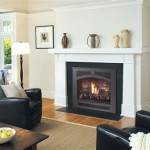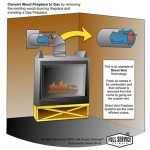Fireplace Brick Panels: A Comprehensive Guide
Fireplace brick panels offer a convenient and aesthetically pleasing solution for renovating or constructing a fireplace surround. Replacing traditional brick with panels provides a cost-effective and less labor-intensive alternative, offering homeowners, builders, and designers a viable option for achieving a classic brick appearance. This article provides a detailed exploration of fireplace brick panels, encompassing their types, advantages, installation, maintenance, and considerations for selecting the appropriate product.
Types of Fireplace Brick Panels
The market presents a diverse range of fireplace brick panels, each characterized by its material composition, aesthetic qualities, and performance characteristics. Understanding these variations is crucial for making an informed decision that aligns with specific project requirements and design preferences.
Faux Brick Panels: These panels are typically manufactured from lightweight materials such as polyurethane foam, cement, or fiberglass composites. They are designed to replicate the appearance of real brick through molded surfaces and painted or stained finishes. Faux brick panels are valued for their ease of installation and affordability. However, it is essential to select panels specifically rated for fireplace applications, considering their fire resistance and heat tolerance.
Thin Brick Panels: Thin brick panels utilize genuine brick slices adhered to a backing material, such as cement board or mesh. These panels offer the authentic look and texture of traditional brick while being significantly lighter and thinner. Thin brick panels provide enhanced durability and heat resistance compared to faux brick panels, making them a suitable choice for fireplace surrounds. The backing material is crucial; fiber cement board is a common and reliable choice for fireplace applications.
Reclaimed Brick Panels: For those seeking a rustic or vintage aesthetic, reclaimed brick panels offer a unique solution. These panels consist of reclaimed brick pieces sourced from demolition sites or salvaged structures. The bricks are cleaned, cut into thinner profiles, and attached to a backing material to form panels. Reclaimed brick panels possess inherent character and historical appeal but may require additional cleaning and sealing to ensure durability and safety.
Manufactured Stone Panels Designed to Mimic Brick: While not technically "brick," some manufactured stone panels are designed to replicate the size, shape, and color variations of brick. These panels often provide enhanced durability and weather resistance, making them suitable for both interior and exterior applications. They are typically made from a blend of cement, aggregates, and pigments, offering a consistent and reliable product.
The selection of panel type should consider the desired aesthetic, budget constraints, and the level of heat exposure the panel will endure. Consultation with a fireplace professional is recommended to ensure compatibility with the fireplace appliance and adherence to local building codes.
Advantages of Using Fireplace Brick Panels
Compared to installing individual bricks, fireplace brick panels offer several distinct advantages in terms of time, cost, and installation complexity. These benefits can make brick panels a preferable option for many fireplace renovation or construction projects.
Simplified Installation: Traditional brick installation involves laying individual bricks, requiring specialized skills and considerable time. Fireplace brick panels, on the other hand, are installed as large sections, significantly reducing the installation time. The panels are typically attached to the fireplace surround using adhesive and mechanical fasteners, such as screws or nails. This streamlined process makes it possible for experienced DIY enthusiasts to complete the project, although professional installation is often recommended to ensure proper fit and safety.
Reduced Labor Costs: The simplified installation process associated with brick panels translates into reduced labor costs. Hiring a contractor to install traditional brick can be expensive, whereas the installation of brick panels typically requires less time and expertise, leading to significant savings. The exact cost savings will depend on the scale of the project, the complexity of the design, and local labor rates.
Lighter Weight: Brick panels, particularly faux brick and thin brick options, are significantly lighter than traditional brick. This reduced weight simplifies handling and transportation, and it may also eliminate the need for structural modifications to the fireplace surround, depending on the original structure. The lighter weight is especially advantageous in older homes where the existing structure may not be able to support the added weight of full-thickness brick.
Design Versatility: Fireplace brick panels are available in a wide range of colors, textures, and styles, providing homeowners and designers with considerable design flexibility. From classic red brick to contemporary gray tones, the options are extensive. Panels can also be cut and shaped to accommodate custom fireplace designs, allowing for unique and personalized aesthetics. The availability of different brick patterns, such as running bond or stacked bond, further enhances design possibilities.
Cost-Effectiveness: While the initial cost of brick panels may vary depending on the material and quality, they often prove to be more cost-effective than traditional brick when considering the overall project expenses. The reduced labor costs, simplified installation, and potential elimination of structural modifications contribute to significant cost savings. This makes brick panels an accessible option for homeowners seeking to enhance the appearance of their fireplace without exceeding their budget.
However, it is important to note that the long-term durability and fire resistance of brick panels may vary depending on the material. Choosing high-quality panels specifically designed for fireplace applications is crucial to ensure safety and longevity.
Installation and Maintenance of Fireplace Brick Panels
Proper installation and maintenance are essential for ensuring the longevity, safety, and aesthetic appeal of fireplace brick panels. Adhering to manufacturer guidelines and implementing regular maintenance practices will help preserve the panels' appearance and structural integrity.
Installation Procedure: The installation process typically involves several key steps. First, the existing fireplace surround must be cleaned and prepared. This may involve removing any existing materials, such as paint or wallpaper, and ensuring that the surface is clean, dry, and level. Second, the panels are measured and cut to fit the dimensions of the fireplace surround. Most panels can be cut using a saw with a masonry blade or a utility knife, depending on the material. Third, adhesive is applied to the back of the panels, and they are carefully positioned and pressed onto the fireplace surround. Mechanical fasteners, such as screws or nails, may also be used to provide additional support. Finally, the joints between the panels are filled with mortar or grout to create a seamless appearance. The choice of mortar or grout should be compatible with the panel material and the desired aesthetic.
Adhesive Selection: Choosing the right adhesive is critical for ensuring a secure and long-lasting bond between the panels and the fireplace surround. High-temperature adhesives specifically formulated for masonry applications are recommended. These adhesives are designed to withstand the elevated temperatures associated with fireplace use. Refer to the panel manufacturer's guidelines for specific recommendations on adhesive types.
Grouting and Mortar Application: Applying grout or mortar to the joints between the panels enhances the aesthetic appeal and provides a weather-resistant seal. The grout or mortar should be applied evenly and smoothly, using a grout float or a mortar bag. Excess grout or mortar should be wiped away with a damp sponge before it dries. The color of the grout or mortar can be matched to the color of the brick panels or chosen to create a contrasting effect.
Sealing: Sealing the brick panels can help protect them from moisture, stains, and fading. A masonry sealer specifically designed for brick or stone should be applied according to the manufacturer's instructions. Sealing is particularly important for panels made from porous materials, such as reclaimed brick or manufactured stone. The frequency of sealing will depend on the type of sealer used and the level of exposure to moisture and wear.
Cleaning and Maintenance: Regular cleaning is essential for maintaining the appearance of fireplace brick panels. The panels can be cleaned using a mild detergent and water solution. Avoid using harsh chemicals or abrasive cleaners, as these can damage the surface of the panels. For stubborn stains, a masonry cleaner specifically designed for brick or stone may be used. It is also important to inspect the panels regularly for any signs of damage, such as cracks or loose pieces. Any damage should be repaired promptly to prevent further deterioration.
Safety Considerations: When working with fireplace brick panels, it is important to observe all necessary safety precautions. Wear appropriate protective gear, such as gloves, safety glasses, and a dust mask. Ensure adequate ventilation when working with adhesives, sealers, or cleaning products. Follow all manufacturer's instructions for the safe use of tools and materials. Consult with a qualified professional if you have any concerns about the safety of the installation process.
Proper installation and ongoing maintenance will ensure that fireplace brick panels provide years of beauty and functionality. By following these guidelines, homeowners can enjoy the classic appeal of brick without the complexities and costs associated with traditional brick installation.

Drystack Tierra Gold Fake Brick Faux Stone Panels

Brick Cladding Panels For Fireplaces

White Brick Fireplace Diy Build With Faux Barron Designs

Hargrove 28 Inch Replacement Fireplace Refractory Panel Single Pack

If You Re Going To Make It Better Fake Diy Brick Fireplace

Brick Boards Heat Resistant Insulating Panels Made From Real Slips

Architectural Details Decorative Wood Paneling Brick Fireplace Makeover Stacked Stone Fireplaces Remodel

Majestic Wtb36 St 36 Inch Weathered Traditional Brick Interior Panels For See Through

Brick Boards Heat Resistant Insulating Panels Made From Real Slips

Fireplaces Smith May Inc
Related Posts








